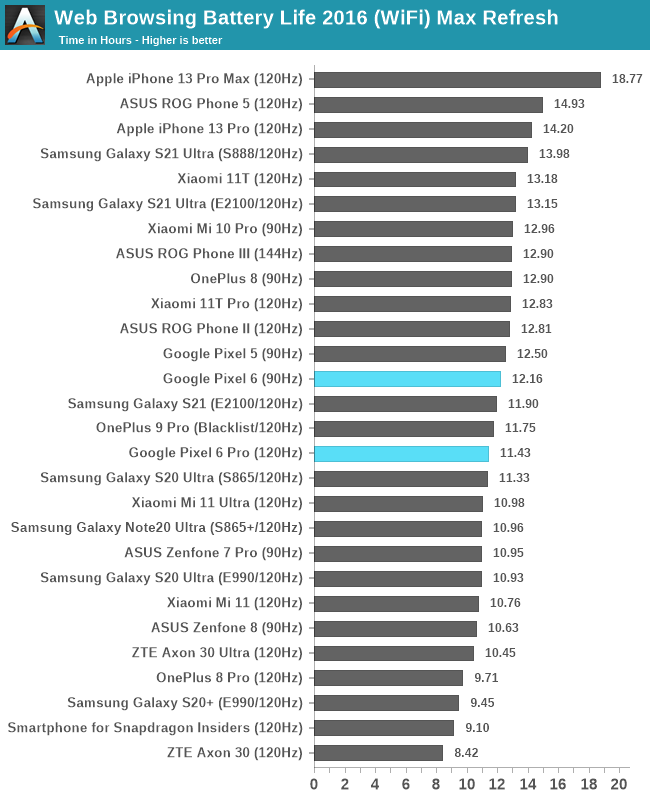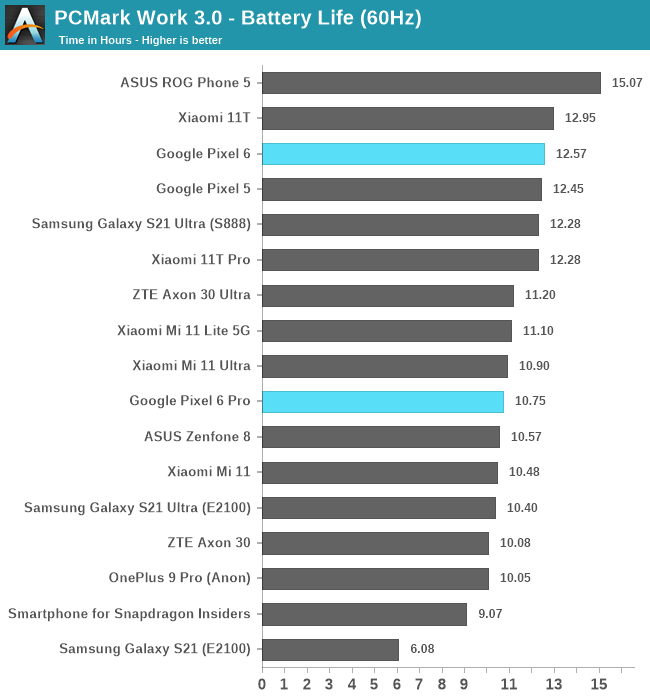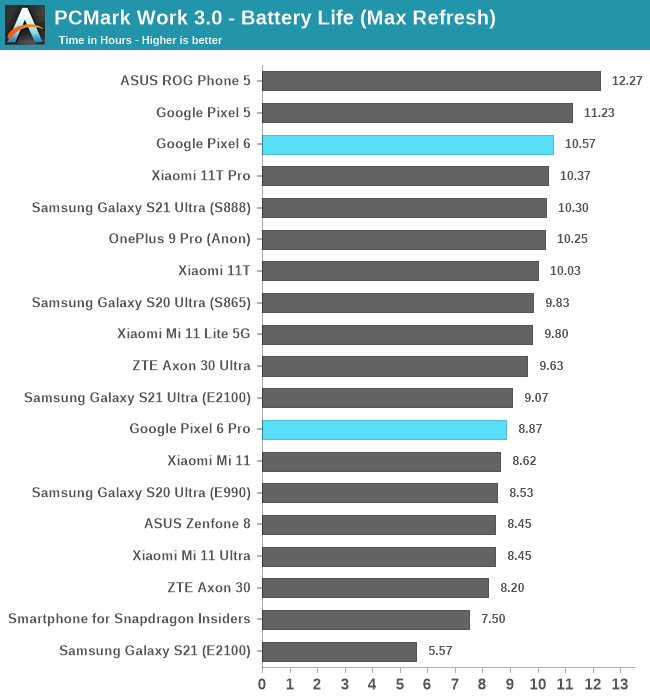Google's Tensor inside of Pixel 6, Pixel 6 Pro: A Look into Performance & Efficiency
by Andrei Frumusanu on November 2, 2021 8:00 AM EST- Posted in
- Mobile
- Smartphones
- SoCs
- Pixel 6
- Pixel 6 Pro
- Google Tensor
Phone Efficiency & Battery Life
While not directly released to the Google Tensor, I also finished running the various battery tests for the Pixel 6 and Pixel 6 Pro, and there are some remarks to be made in regards to the power efficiency of the devices, and how the new SoC ends up in relation to the competition.
As a reminder, the Pixel 6 comes with a 4614mAh battery and a 6.4” 1080p 90Hz OLED screen, while the Pixel 6 Pro features a 5003mAh battery and a 6.71” 1440p 120Hz OLED display, with variable refresh rate from 10-120Hz.

Starting off with the 60Hz web browsing results, both Pixel phones end up extremely similar in their longevity, at 14 hours runtime. The regular Pixel 6 is hard to compare things to as we don’t have too many recent phones with 90Hz displays in our results set, however the Pixel 6 Pro should be a direct comparison point to the S21 Ultras, as both feature 5000mAh batteries and similar display characteristics. The P6Pro here ends up slightly ahead of the Exynos 2100 S21 Ultra, which might not be too surprising given that the Tensor chip does end up at somewhat lower CPU power levels, even if performance is lower. It’s still quite behind the Snapdragon 888 variant of the S21 Ultra – which is again quite representative of the SoC efficiency differences.

Running the phones at their respective max refresh rates, both devices see larger drops, however the Pixel 6 Pro especially sees a more substantial hit. This time around, the 6 Pro ends up significantly behind the Exynos 2100 S21 Ultra, which had only a minor drop in the 60 -> 120Hz results.

Shifting over to PCMark at 60Hz, we see that there’s a larger difference in favour of the Pixel 6, as the Pixel 6 Pro ends up behind it in longevity by almost two hours. The 6 Pro still ends up in line with the E2100 S21U, however that device showcases significantly higher performance numbers in the test, which acts both as a performance metric for device responsivity as well as a battery life test.

At 120Hz, the 6 Pro ends up worse than the E2100 S21U, and quite worse than the S888 S21U.
When I was investigating the phones, the 6 Pro’s power behaviour was quite weird to me, as I saw best-case baseline power figures of around 640mW, and sometimes this inexplicably would also end up at 774mW or even higher. What this reminded me of, was the power behaviour of the OnePlus 9 Pro, which also suffered from extremely high baseline power figures. Both the 6 Pro and the 9 Pro advertise themselves as having LPTO OLED panels, but both of them very clearly do not behave the same as what we’ve seen on the Note20Ultra or the S21Ultra phones. The 6 Pro also only goes up to up to 750 nits 100% APL peak brightness in auto-brightness mode under bright ambient light, which is significantly lower than the S21U’s 942 nits. I think what’s happening here is that the Pixel 6 Pro simply doesn’t have the most state-of-the-art display, and thus is quite less efficient as what we find on the competition. It does kind of make sense for the price-point of the phone, but also explains some of the battery behaviour.
Naturally, the Tensor SoC also just doesn’t appear to be as efficient. Particularly many UI workloads would be run on the A76 cores of the chip, which just outright have a 30% perf/W disadvantage. The phone ends up OK in terms of absolute battery life, however performance metrics are lower than other devices.
I think the regular Pixel 6 here is just a much better device as it doesn’t seem to have any particular issues in display efficiency, even if it’s just a 1080 90Hz panel. There are naturally experience compromises, but it’s also a $599 phone, so the value here is very good.
US readers who are used to Qualcomm phones might also encounter efficiency regressions when under cellular data – we abandoned doing testing here many years ago due to the impossible task to get consistent test environments.










108 Comments
View All Comments
Wrs - Wednesday, November 3, 2021 - link
It’s Double data rateNaturalViolence - Wednesday, December 1, 2021 - link
So you're saying the data rate is actually 6400MHz? LPDDR5 doesn't support that. Only regular DDR5 does.Eifel234 - Wednesday, November 3, 2021 - link
I've had the pixel 6 pro for a week now and I have to say it's amazing. I don't care what the synthetic benchmarks say about the chip. It's crazy responsive and I get through a day easily with heavy usage on the battery. At a certain point extra CPU/gpu power doesn't get you anywhere unless your an extreme phone gamer or trying to edit/render videos both of which you should really just do on a computer anyway. What I care mostly about is how fast my apps are opening and how fast the UI is. Theres a video comparison on YouTube of the same apps opening on the iPhone 13 max and the p6 pro and you know what the p6 pro wins handily at loading up many commonly used apps and even some games. Regarding the battery life, I expect to charge my phone nightly so I really don't care if another phone can get me a few more hours of usage after an entire day. I can get 6 hours of SOT and 18 hours unplugged on the battery. More than enough.Lavkesh - Thursday, November 11, 2021 - link
Well that would be true if iOS apps were the same as Android apps. In the review of A15, it was called out how Android AAA games such as Genshin Impact were missing visual effects altogether which were basically present in iOS. These app opening tests are pretty obtuse in my opinion and it checks out as well. For a more meaningful comparison, have a look at this and how badly this so called google soc is spanked by A15!Here's Exynos 2100 vs Google Pixel 6
https://www.youtube.com/watch?v=iDjzPPtC4kU&t=...
Here's Exynos 2100 vs iPhone
https://www.youtube.com/watch?v=U9A91bnVBU4
Arbie - Friday, November 5, 2021 - link
No earphone jack, no sale.JoeDuarte - Saturday, November 6, 2021 - link
This piece has been up for three days, and there are still tons of typos and errors on every page? How is this happening? Why doesn't AnandTech maintain normal standards for publishers? I can't imagine publishing this piece without reading it. And after publishing it, I'd read it again – there's no way I wouldn't catch the typos and errors here. Word would catch many of them, so this is just annoying."...however it’s only 21% faster than the Exynos 2100, not exactly what we’d expect from 21% more cores."
The error above is substantive, and undercuts the meaning of the sentence. Readers will immediately know something is wrong, and will have to go back to find the correct figure, assuming anything at AnandTech is correct.
"...would would hope this to be the case."
That's great. How do they not notice an error like that? It's practically flashing at you. This is just so unprofessional and junky. And there are a lot more of these. It was too annoying to keep reading, so I quit.
ChrisGX - Monday, November 8, 2021 - link
Has Vulkan performance improved with Android 12? That is a serious question. There has been some strange reporting and punditry about the place that seems intent on strongly promoting the idea that the Tensor Mali GPU is endowed with oodles and oodles of usable GPU compute performance.In order to make their case these pundits offer construals of reported benchmark scores of Tensor that appear to muddle fact and fiction. A recent update of Geekbench (5.4.3), for instance, in the view of these pundits, corrects a problem with Geekbench that caused it to understate Vulkan scores on Tensor. So far as I can tell, Primate Labs hasn't made any admission about such a basic flaw in their benchmark software, that needed to be (and has been) corrected, however. The changes in Geekbench 5.4.3, on the contrary, seem to be to improve stability.
I am hoping that there is a more sober explanation for the recent jump in Vulkan scores (assuming they aren't fakes) than these odd accounts that seem intent on defending Tensor from all criticism including criticism supported by careful benchmarking.
Of course, if Vulkan performance has indeed improved on ARM SoCs, then that improvement will also show up in benchmarks other than Geekbench. So, this is something that benchmarks can confirm or disprove.
ChrisGX - Monday, November 8, 2021 - link
The odd accounts that I believe have muddled fact and fiction are linked here:https://chromeunboxed.com/update-geekbench-pixel-6...
https://mobile.twitter.com/SomeGadgetGuy/status/14...